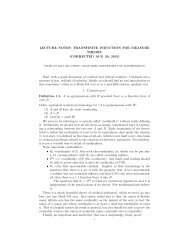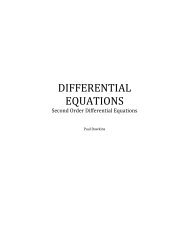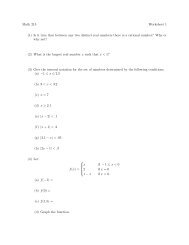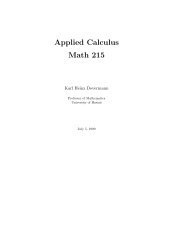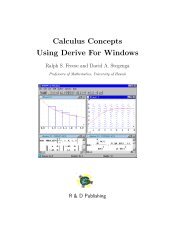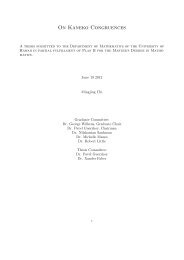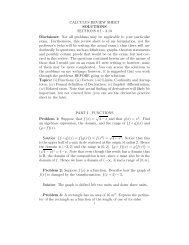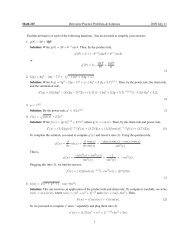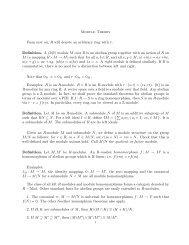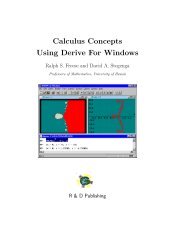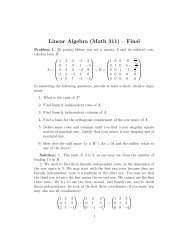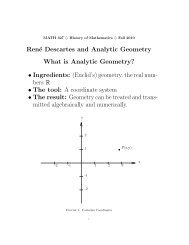Problems and Solutions in - Mathematics - University of Hawaii
Problems and Solutions in - Mathematics - University of Hawaii
Problems and Solutions in - Mathematics - University of Hawaii
Create successful ePaper yourself
Turn your PDF publications into a flip-book with our unique Google optimized e-Paper software.
1.5 2001 November 26 1 REAL ANALYSIS<br />
(i) If 1 < p < ∞ <strong>and</strong> 1 1<br />
p + q = 1, then fg1 = fpgq. Thus, if f ∈ Lp <strong>and</strong> g ∈ Lq , then fg ∈ L1 (ii) If p = ∞ <strong>and</strong> if f ∈ L ∞ <strong>and</strong> g ∈ L 1 , then |fg| ≤ f∞|g|, so fg1 ≤ f∞g1.<br />
(d) (Riesz representation theorem for L p ) 25<br />
Suppose 1 < p < ∞ <strong>and</strong> 1<br />
p<br />
+ 1<br />
q = 1. If Λ is a l<strong>in</strong>ear functional on Lp , then there is a unique g ∈ L q such that<br />
<br />
Λf = fg dµ (∀f ∈ L p ).<br />
(e) (Hahn-Banach theorem)<br />
Suppose X is a normed l<strong>in</strong>ear space, Y ⊆ X is a subspace, <strong>and</strong> T : Y → R is a bounded l<strong>in</strong>ear functional.<br />
Then there exists a bounded l<strong>in</strong>ear functional ¯ T : X → R such that ¯ T (y) = T (y) for all y ∈ Y , <strong>and</strong> such that<br />
¯ T X = T Y , where ¯ T X <strong>and</strong> T Y are the usual operator norms,<br />
¯ T X = sup{| ¯ T x| : x ∈ X, x ≤ 1} <strong>and</strong> T Y = sup{|T x| : x ∈ Y, x ≤ 1}.<br />
4. (a) State the Baire category theorem.<br />
(b) Prove the follow<strong>in</strong>g special case <strong>of</strong> the uniform boundedness theorem: Let X be a (nonempty) complete metric<br />
space <strong>and</strong> let F ⊆ C(X). Suppose that for each x ∈ X there is a nonnegative constant Mx such that<br />
|f(x)| ≤ Mx for all f ∈ F.<br />
Prove that there is a nonempty open set G ⊆ X <strong>and</strong> a constant M > 0 such that<br />
|f(x)| ≤ M holds for all x ∈ G <strong>and</strong> for all f ∈ F .<br />
Solution: 26<br />
(a) (Baire category theorem)<br />
If X is a complete metric space <strong>and</strong> {An} is a collection <strong>of</strong> open dense subsets, then ∞<br />
n=1 An is dense <strong>in</strong> X.<br />
Corollary 1. If X is a complete metric space <strong>and</strong> G ⊆ X is a non-empty open subset <strong>and</strong> G = ∞ o<br />
= ∅ for at least one n ∈ N.<br />
¯<br />
Gn<br />
Corollary 2. A nonempty complete metric space is not a countable union <strong>of</strong> nowhere dense sets.<br />
n=1 Gn then<br />
(b) Def<strong>in</strong>e Am = {x ∈ X : |f(x)| ≤ m, ∀f ∈ F }. Then X = ∞ m=1 Am, s<strong>in</strong>ce for every x there is a f<strong>in</strong>ite<br />
number Mx such that |f(x)| ≤ Mx for all f ∈ F . Now note that Am = <br />
f∈F {x ∈ X : |f(x)| ≤ m}, <strong>and</strong>, s<strong>in</strong>ce f<br />
<strong>and</strong> a ↦→ |a| are cont<strong>in</strong>uous functions, each {x ∈ X : |f(x)| ≤ m} is closed, so Am is closed. Therefore, corollary<br />
2 <strong>of</strong> the Baire category theorem implies that there must be some m ∈ N such that A◦ m = ∅, so the set G = A◦ m <strong>and</strong><br />
the number M = m satisfy the given criteria. ⊓⊔<br />
25 Note to self: add case p = ∞<br />
26 See Royden [6], § 7.8, for an excellent treatment <strong>of</strong> this topic. Part (b) <strong>of</strong> this problem appears there as theorem 32, <strong>and</strong> another popular exam<br />
question is part c <strong>of</strong> problem 37.<br />
22




